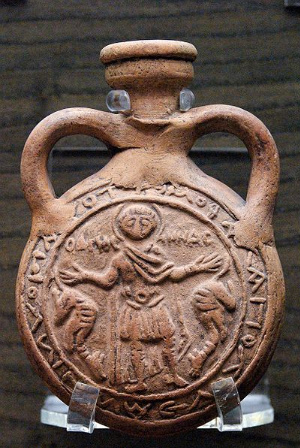Ampullae Abu Mina

Dating from the 6th-7th century CE, this ampulla or flask is from the site of Abu Mina. Abu Mina was a major religious pilgrim destination; pilgrims journeyed to the holy city, which included a monastery as well as the tomb of St. Menas, for prayer and healing. Many of these flasks were produced and sold to pilgrims, who would fill them with holy water and oils, conveniently available at the site of St. Menas' tomb, and then bring the liquids back home with them. This particular flask has Coptic writing on it, which would have appealed to the Coptic Christians. It has been suggested that the center image, probably St. Menas himself, holding two animals by their tails, is an allusion to the Mesopotamian "master of the animals" motif, an example of how outside cultures influenced Egyptian art.
